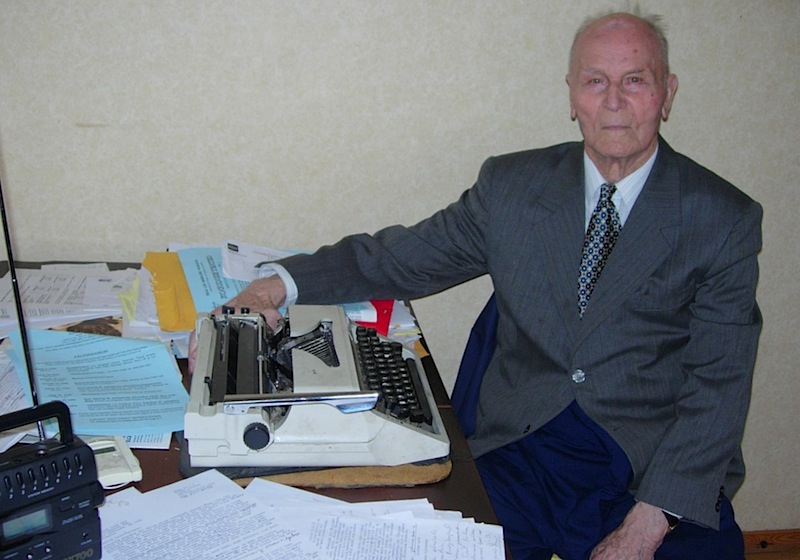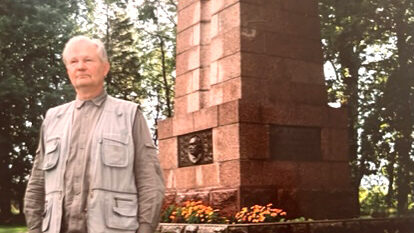I too got hit several occasions, with the number of hits measured according to her schedule. This occurred during oral math exercises. She would yell out two four digit numbers, point to a student who would then have to repeat the numbers and then quickly call out the sum. I could speak German fairly well but remembering numbers was confusing for me. For example in German twenty two is spoken as two-and-twenty. So she caught me several times not responding quickly enough.
My worst of memory of Miss. Birnbaum was from the time when she decided to make an example of a kid who was occasionally late. The fact that he had to walk to school a great distance did not matter. In front of the classroom was a life-sized framed picture of der Führer, Adolf Hitler, whom every student entering the classroom would have to salute with a loud “Hail Hitler” while throwing his right hand out straight. This had to be done even when the class work had started. Of course, latecomers were very disruptive. One time when the boy had once again defied the clock, Miss. Birnbaum called in the principal, Mr. Furtmayr, a former army officer who had lost a leg in the war and walked with a crutch. He entered and in front of the class, beat the boy mercilessly with his crutch while yelling. Needless to say, I was never late.
When the war ended Miss. Birnbaum was released because of her Nazi party membership. She was replaced with Mrs. Baumbusch, a kind person. I remember her because of the contrast with her predecessor. I continued to go to the village school until my parents and I moved to the aforementioned DP camp. After I left Mrs. Baumbusch encouraged her students to write me in the camp. I appreciated that and responded with a letter.
I have more complete memories of teachers from my years in gymnasium before emigrating to the US and of high school after emigrating. After leaving our unique small grade school in camp Insula we moved to the city of Geislingen, where over 4000 Estonian refugees were housed. Here I entered the Estonian gymnasium which I attended until emigrating in the middle of my sophomore year. I have written about my experiences in the gymnasium in the album “Geislingeni Eesti Gümnaasiumi Õpilaste ja Õpetajate Elulugusid,” (“Life stories of students and teachers of the Estonian Gymnasium in Geislingen”) a compilation of experiences by 260 students and teachers that I edited. Here the contact was less personal between the students and teachers. The teachers were professional and their teaching was targeted. Still there were inspiring moments like when our geography teacher Paul Lannus drew the profiles of Africa and South America on the black-board and showed how the shorelines matched! The land masses must have separated! Only much later was this fact substantiated by of research done on the Atlantic Ocean floor, but I accepted it as fact already in 1948 in Mr. Lannus's class.

The gymnasium had the no-nonsense curriculum of prewar Estonia. Our texts were brought from Estonia by fleeing teachers, retyped and mimeographed. The human side of my experience included watching Mr. Laan, our language teacher, pick on a student called Maise-poiss, whose attendance was spotty and class participation not up to Mr. Laan's standards. Mr. Laan kept picking on him until he quit coming to school. Mr. Laan did something else that I never could quite understand: he took our skull dimensions, one student at a time, and made some kind of judgments based on them.
My best experience was in the Religious education classes with Rev. Johannes Aarik. He allowed freewheeling discussions in class. Rather than conducting the class from the front, he leaned against the window ledge on the side of the class room which I believe was symbolic. The discussions were frank and engaging. I declared myself an atheist in the process but also formed a lifelong friendship with him. After his return to Estonia upon his retirement I visited him every time I went to Estonia at his home in Nõmme, until his death in 2011. I found it flattering that he would engage me in deep religious topics, but then again he himself was a bit of a rebel.
(to be continued)
Arved Plaks, January 2013




